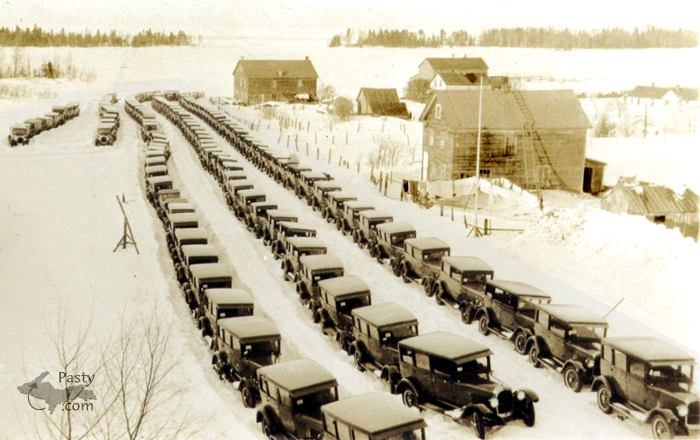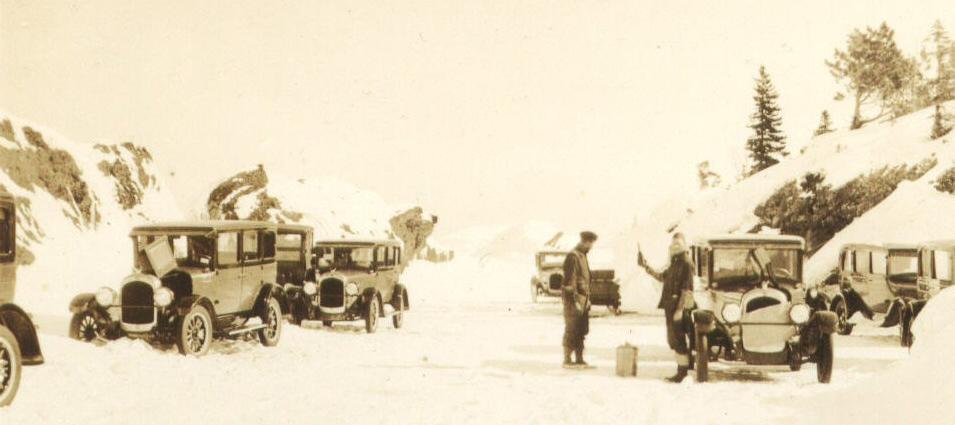By Martha Lantz (Wishin2bintheup) on Monday, March 6, 2006 - 10:50 pm:
The City of Bangor has been a familiar name in our family for as long as I can remember. I grew up in Copper Harbor in the house that my father grew up in. My father, William Howard Bergh, would tell about when he was 13 years old he and his father were coming back from the barn on December 1, 1926, when they heard the swishing sound of oil skins. My grandfather knew that it must be a sailor coming because they were the ones who wore oil skins. He also knew there must be trouble. The man, who was with the Coast Guard, told my grandfather that the crew of the Bangor was at "Fred the Swede's" (A local boarding house and tavern). There was not enough room or food for them there because the crew from the steamer, "Maytham" which had run aground at Pt. Isabelle was already there. He asked my grandfather if the crew could stay at his house. My grandfather had just killed two pigs, which they were hoping would get the family through most of the winter until the road to Calumet was passable again (they didn't plow it back then!) and they could get supplies. Well, of course my grandfather said that the crew from the City of Bangor could stay at their house. My father and his younger brother, Albert, were sent to go get the men and lead them the 1/2 mile to our house. He didn't understand why the men could hardly walk and kept falling down. He didn't realize that they had been struggling through the hip-deep snow, brush and swamps for the better part of 2 days. My father said that most of the crew were from the Detroit area, and that they were not dressed for Upper Michigan winter weather. He said that they just had loafer shoes and light weight clothes. Some of the men had taken blankets and torn them into strips and wrapped the strips around their legs. Then the snow got underneith and formed ice against their legs. The men were totally exhausted, dehydrated, hungry and frost bitten. They had seen East Bluff through the blinding snow, and throught it was West Bluff, or Brockway Mountain, and thought they had gone past Copper Harbor. They had walked the wrong direction for several hours. Then when they realized their mistake, had to turn around and retrace their steps. When the 27 men got to the house, they just lay down all over the floor and fell asleep. As they began to thaw out, puddles would accumulate around the men. It was my father's job to mop up around them. My father's older sister helped my grandmother prepare meals for the men. The men stayed for about a week. Then, Captain Tony Glaza of the Coast Guard returned with his boat to take the men to Eagle Harbor and then on to Calumet to the Hospital, but a strong Northeast wind kept him at our dock long enough for the harbor to freeze over for the winter. It was then up to Charlie Maki's sleigh to transport the men to Calumet.
The City of Bangor was a 450-500 ft. car carrier. It had a cargo of new Chryslers. During the Bangor's voyage, the waves whipped 18 cars off the deck and they are probably still somewhere between Copper Harbor and Horseshoe Harbor. In fact, before Lake Superior froze over, the ship was covered in a thick coat of ice. In mid-December, 1926, the rest of the cars were lowered down to the water level (now ice). Teams of horses cleared a road along the ice to Copper Harbor and soon after Christmas, the vehicles were driven to Copper Harbor under their own power and parked for the rest of the winter. My father and grandfather helped drive the cars from the boat to Copper Harbor. As not all the cars had their own batteries, they had to take the battery out once they got it to Copper Harbor and send it back to be put into another car. As next year's Chryslers were already being drawn, it was important that the City of Bangor vehicles be returned to Detroit to be put back on the market as soon as possible--as soon as possible being whenever the road between Copper Harbor and Phoenix could be opened. No attempt was made until March, and even then it took two weeks work for Houghton and Keweenaw County plows, assisted by a unit from Albert Lea, Minnesota, to do the job. This was the first time that US 41 was plowed between Copper Harbor and Phoenix. 400 cars were driven to Calumet between 8-10 ft. high snowbanks. The Chrysler people offered five dollars to every person who drove a car through. There were very few Calumet boys that didn't get out of school to drive a car. By the first of April, all but two cars had been loaded on flatcars and shipped back to Detroit.
By Deb S. (Usedtobeayooper) on Tuesday, March 7, 2006 - 07:39 am:
Martha, What an interesting story. It reminds me of some of the stories that are told in the Lake Superior magazine. I bet they'd be interested in that one. It kept me hooked. Thanks for sharing.
By Sdcferndale (Sdcferndale) on Tuesday, March 7, 2006 - 12:27 pm:
Did anyone see the History Channel last night at 10:00 PM. Deep Sea Divers I think it was called. They were exploring the old train car carrier I think it was the Milwaukee that sunk late October 1926 with a lot of train cars in Lake Michigan during a terrible storm. All hands were lost. The divers concluded so much water got in the stern and down open hatches which resulted in the sinking. The captain had just come from Michigan to Wisconsin, loaded up and was heading back to Michigan into this storm which equated to a Perfect Storm. It was very interesting to hear the divers' conclusion of why it sank.





